Civil Rights sites in Alabama bring history to life, marking the places where the fight for justice changed a nation. From Montgomery to Selma, these landmarks offer a powerful window into the struggles and triumphs of the Civil Rights movement.
Here’s what you need to know.
An introduction to Civil Rights sites in Alabama
Travelling to Alabama can stir up a lot of mixed feelings. The birthplace of the 1950s Civil Rights Movement runs today on a typical Southern rhythm, home to friendly people who welcome visitors with a smile.
Live blues and jazz still fill the bars in Birmingham and Montgomery, giving these places an undeniable energy. And in cities like Mobile and Tuscaloosa, college football is loud, joyful, and almost religious in its intensity.
But Alabama has a quiet side as well, a side that inspires reverence for those who were part of the American Civil Rights Movement. For decades, its cities have witnessed struggles against racial segregation, rallies for social justice, and landmark moments that have reshaped the entire nation.
In 2025, Alabama will mark several significant anniversaries: the 60th anniversary of Bloody Sunday and the Selma to Montgomery Voting Rights March, as well as the 70th anniversary of the Montgomery Bus Boycott.
With newly restored landmarks and museums under the care of the National Park Service, the state is becoming an essential destination for history enthusiasts.
If you’re visiting this year, here’s what you shouldn’t miss.
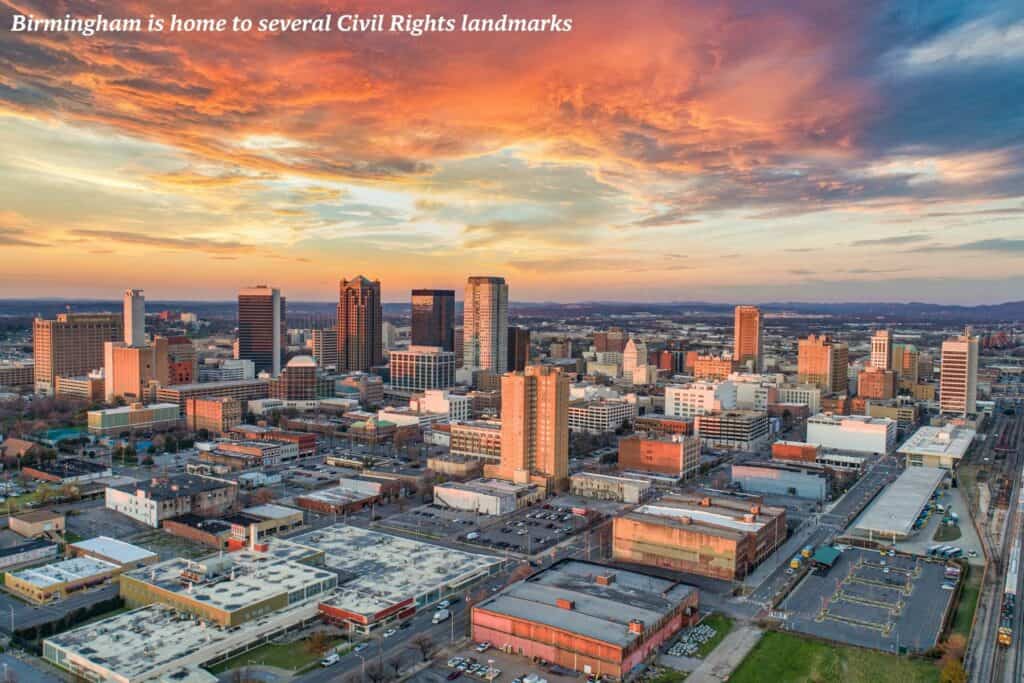
Birmingham
Birmingham is a city of contrasts. As you walk around it, you’ll notice a mixture of old steel factories, new structures, green parks and key landmarks that remind you of its importance in the Civil Rights Movement.
Its history is representative of the Southern states, with public spaces that mark the spots where non-violent protesters once confronted white supremacists.
Birmingham Civil Rights Institute
For a sharp plunge into the history of the fight for racial integration, start your itinerary at the Birmingham Civil Rights Institute, part of the Birmingham Civil Rights National Monument. This museum is an interactive centre that offers access to photos and documents, as well as first-hand accounts of how Black people battled systemic segregation every day.
You’ll learn a lot from the short film they play at the Orientation Theater on the premises, which includes interviews with foot soldiers of the movement.
See what lunch counter sit-ins looked like, what it meant for Black Americans to ride segregated city buses, and the tension around the infamous Birmingham Jail, where Dr Martin Luther King Jr. wrote his powerful letter demanding equality.
16th Street Baptist Church
A five-minute walk from the Institute stands the 16th Street Baptist Church, a national historic landmark with a beautiful red-brick facade and twin bell towers, which were restored after one of the darkest acts of violence by white supremacists in the 1960s.
Inside, the sanctuary is warm and welcoming.
Sunlight filters through stained-glass windows, including one that depicts a Black Jesus – a symbol of healing and justice for the Black community.
But there’s also a heaviness in the air, an unspoken acknowledgement that this space once bore witness to violence and loss.
Standing in the very place where four young girls – Addie Mae Collins, Cynthia Wesley, Carole Robertson, and Denise McNair – lost their lives is overwhelming. The bombing, carried out by the KKK, was meant to instil fear, but instead, it became a turning point in the Civil Rights Movement.
Kelly Ingram Park
Cross the street to discover Kelly Ingram Park, a key place in Birmingham’s Civil Rights history. It’s quiet now, but in the 60s, it witnessed atrocious events including police dogs attacking protestors and water cannons being turned on children.
These confrontations – now depicted by bronze sculptures – captured national attention and intensified the discussions about social justice and human rights.
A.G. Gaston Motel (newly restored in 2025)
In 2025, Birmingham gained a revitalised landmark: the A.G. Gaston Motel. Once a meeting place for key Civil Rights activists – including Dr. Martin Luther King Jr. – it played a key role in the Birmingham Campaign.
The motel belonged to the entrepreneur A.G. Gaston, who was Birmingham’s first Black millionaire at a time when racial segregation limited many avenues for African Americans.
New exhibits shed light on Gaston’s contributions – he provided lodging and conference rooms where activists strategised and penned letters that reached the ears of the entire nation.
The motel’s fresh look and state-of-the-art multimedia displays offer travellers an entirely new way to explore Civil Rights sites in Birmingham. If you have extra time, make sure to visit the onsite café, which sources produce from local farms.
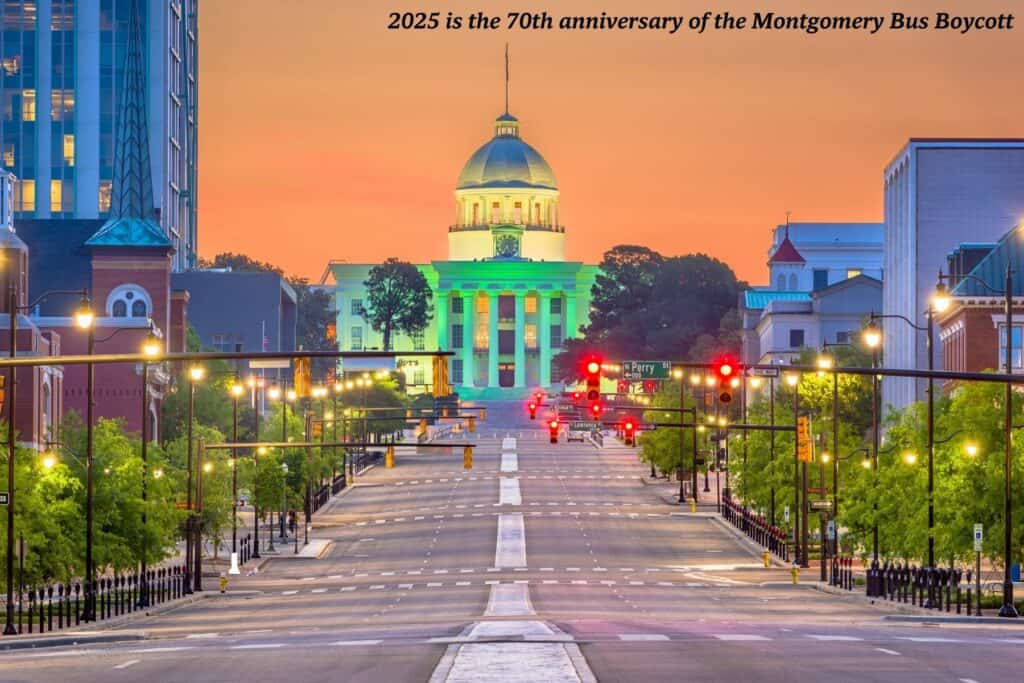
Montgomery
In 2025, Montgomery commemorates the 70th anniversary of the Montgomery Bus Boycott, a moment that ignited waves of activism across the United States. While here, explore museums, enjoy regional cuisine, and take a stroll along the newly designated Montgomery National Historic Trail.
Rosa Parks Museum and Library
Back in 1955, Rosa Parks was riding one of Montgomery’s segregated city buses, as was the norm at the time. She was tired – physically and emotionally – of giving up her seat just because she was Black. So when the bus driver asked her to move to a accommodate a white passenger, Rosa Parks refused to yield.
Situated on the campus of Troy University, the Rosa Parks Museum and the adjacent Rosa Parks Library stand as tribute to this defining moment in the city buses protest of 1955.
Inside, interactive exhibits walk you through the story of how the boycott started, capturing the tension, courage, and the worldwide shock that followed.
There’s even a short a recreation of the bus scene that provides a sense of how precarious it was for African Americans to challenge legalised segregation in the American South.
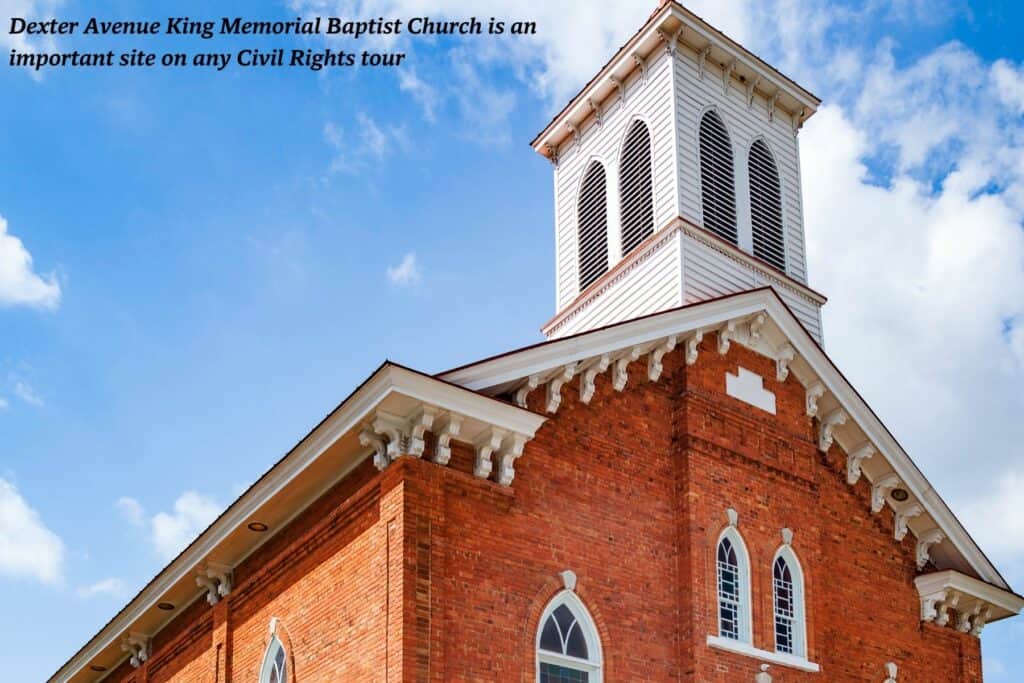
Dexter Avenue King Memorial Baptist Church & Parsonage
At the corner of Dexter Avenue stands the historic Dexter Avenue King Memorial Baptist Church, where Dr. Martin Luther King Jr. once served as pastor. This very church played a crucial role in planning the Montgomery Bus Boycott, making it a key landmark on any Civil Rights tour.
Inside, the main sanctuary remains unchanged, allowing visitors to step back in time to the 1950s when King delivered his sermons during a turbulent era. You can also visit the parsonage, where King lived with his family.
The original furniture has been preserved, offering an intimate glimpse into his daily life. The parsonage was bombed in 1956, and the damage remains visible.
Don’t forget to explore the church basement, where mass meetings and strategy sessions for the movement were once held.
Civil Rights Memorial Center
Designed by Maya Lin – the same architect behind the Vietnam Veterans Memorial in Washington, D.C. – the Civil Rights Memorial Center features a black granite table with water flowing over the names of 40 individuals who were killed during the Civil Rights Movement.
Nearby, you’ll find a black granite wall which is engraved with Dr. Martin Luther King Jr.’s words:
“Until justice rolls down like waters and righteousness like a mighty stream.”
Visit the centre to learn about the lesser-known martyrs of the Movement whose names are sometimes overshadowed by more famous figures.
Equal Justice Initiative Legacy Sites
As you continue exploring Montgomery, three must-visit legacy sites are the Legacy Museum, the National Memorial for Peace and Justice and the Freedom Monument Sculpture Park.
Both historical sites, developed by the Equal Justice Initiative (EJI), have undergone new expansions in 2025, introducing immersive experiences that transport visitors into historical contexts.
The Legacy Museum
Housed on a site where enslaved people were once held, the museum uses striking visuals and historical documents to trace the legacy of racial injustice from slavery through to modern-day mass incarceration.
You can explore newly added sections that detail the stories of individual Black Americans, see a recreated slave pen, and learn about the evolution of racial segregation laws.
The National Memorial for Peace and Justice
This landmark is known as the country’s first national lynching memorial, and standing inside it is silencing. The rows of steel columns hanging, each inscribed with names of those who fell victim to racial terror, speak for those who no longer can.
Freedom Monument Sculpture Park
History becomes even more real with the Freedom Monument Sculpture Park, which opened last year on the Alabama River. The park commemorates another period in the life of the Black community in the area: the arrival of the enslaved people who were brought to Alabama through the city’s salve docks.
Bonus: If you’re a fan of Fitzgerald’s novels, this year marks the centenary of The Great Gatsby, and Montgomery – where F. Scott and Zelda Fitzgerald lived briefly from 1931 to 1932 – offers a special treat. Their former home is now a museum, and for an even more immersive experience, you can rent one of the two apartments upstairs.
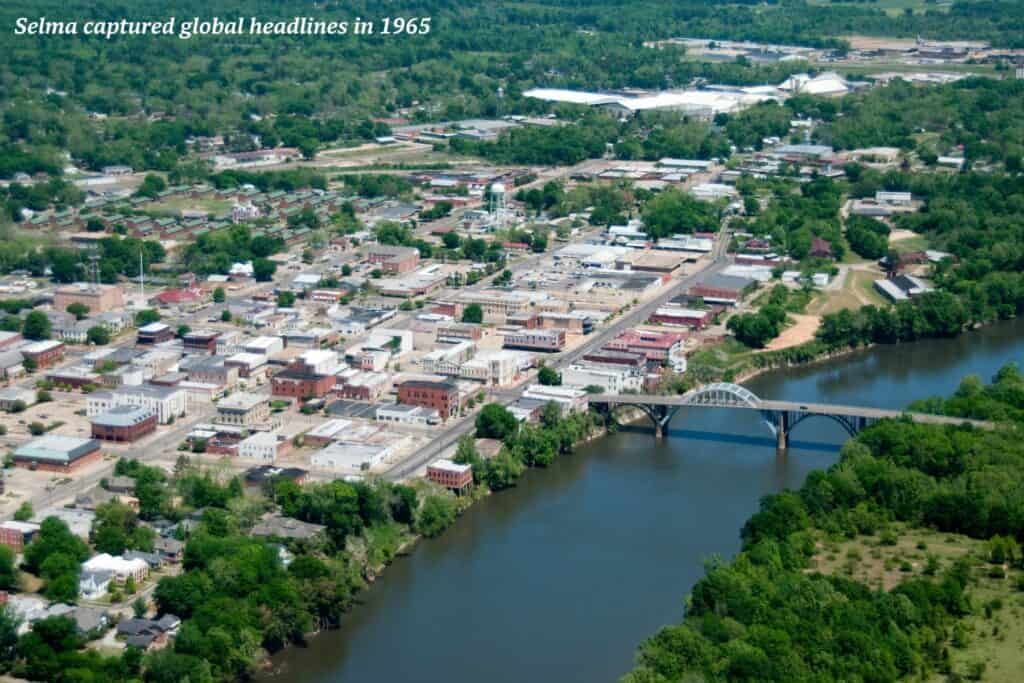
Selma
Prepare to discover Selma, a small town that captured global headlines in 1965 when non-violent protesters marched across the Edmund Pettus Bridge in an effort to secure equal ballot access.
What started as a peaceful demonstration turned into Bloody Sunday, as state troopers used tear gas and batons to beat the protesters, propelling Civil Rights history onto front pages worldwide.
In 2025, Selma commemorates the 60th anniversary of that Voting Rights March, recognising the bravery of ordinary citizens who became legendary foot soldiers.
Wondering where to stop in Selma? Here’s where to go.
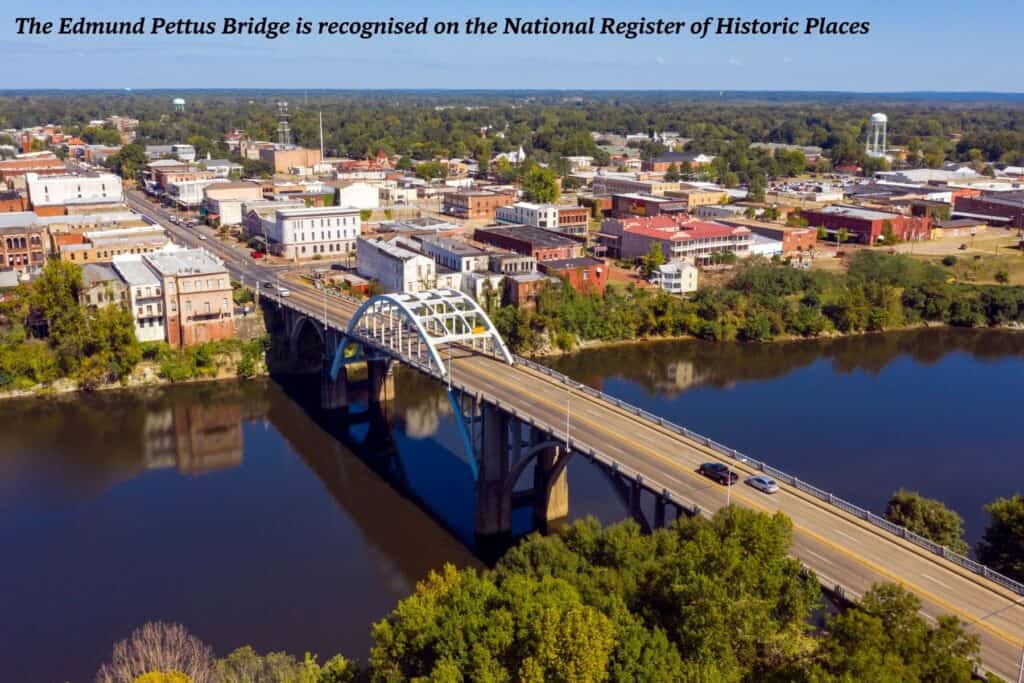
Edmund Pettus Bridge
When you arrive at the Edmund Pettus Bridge, you’ll be stuck by how modest the structure is. However, once you learn about the events that took place here, you’ll feel it shift beneath your feet.
The Bloody Sunday led to the Voting Rights Act – so it played an important role in furthering the movement – but ultimately, it was a day that ended in chaos and loss.
Today the bridge is officially recognised on the National Register of Historic Places, and it attracts visitors from across the entire nation and beyond.
Selma Interpretive Center & National Voting Rights Museum
Step off the bridge and allow some time to learn about the Selma to Montgomery March at the Selma Interpretive Center, which also contributed to passing the Voting Rights Act.
Next door is the National Voting Rights Museum, a place that adds personal depth through galleries of photographs, testimonies, and interactive components.
Its displays chronicle the mass meetings that took place at local churches, emphasising the efforts of the often-overlooked women and youth activists.
If you are visiting during Black History Month, you will find additional seminars and workshops that delve deeper into the intersection of race, politics, and community empowerment.
Brown Chapel AME Church
Churches played a vital role during the movement as one of the few places where Black people were permitted to gather and meet. In Selma, the most important one was located on the city’s east side and was known as the Brown Chapel AME Church.
It is still there, preserved by ongoing restoration work, still talking about the inspirational sermons, which offered moral support to the protesters as they prepared to face the state troopers on the Edmund Pettus Bridge.
Tuskegee
Tuskegee is another essential stop on any Civil Rights tour of Alabama, thanks to its trailblazing efforts in both education and military integration.
The town’s commitment to progress can be traced through historical marker signs, local museums, and century-old institutions that shaped Black Americans’ futures.
Here are a few must-see stops.
Tuskegee Airmen National Historic Site
This historic site takes us back to World War II when Black men were first allowed to become pilots in the United States military. Black pilots played a crucial role in the war, but they also brought hope to their communities, encouraging them to believe that racial segregation could be overcome.
The exhibitions talk about their bravery and the special training programmes they had to follow, but they also expose the discrimination these men faced.
Tip: Consider scheduling a guided tour that includes Hangar One, which often hosts interpretive presentations on flight simulators and original uniforms.
Tuskegee Institute National Historic Site
Down the road sits the Tuskegee Institute National Historic Site, a national historic landmark that honours the work of Booker T. Washington and George Washington Carver.
The sprawling campus remains dedicated to educating African Americans, reflecting Washington’s vision of economic and academic self-sufficiency.
Stop by Booker T. Washington’s home, The Oaks, or visit Carver Museum’s interactive displays that detail Carver’s experiments with peanuts and crop rotation, revolutionary ideas for the American South at the time.
Tip: If you are searching for local fare, you’ll find lots of eateries around downtown Tuskegee serving catfish, collard greens, and cornbread – traditional Southern cuisine that resonates with travellers who want to sample authentic flavours. You can read more about food in Alabama here.
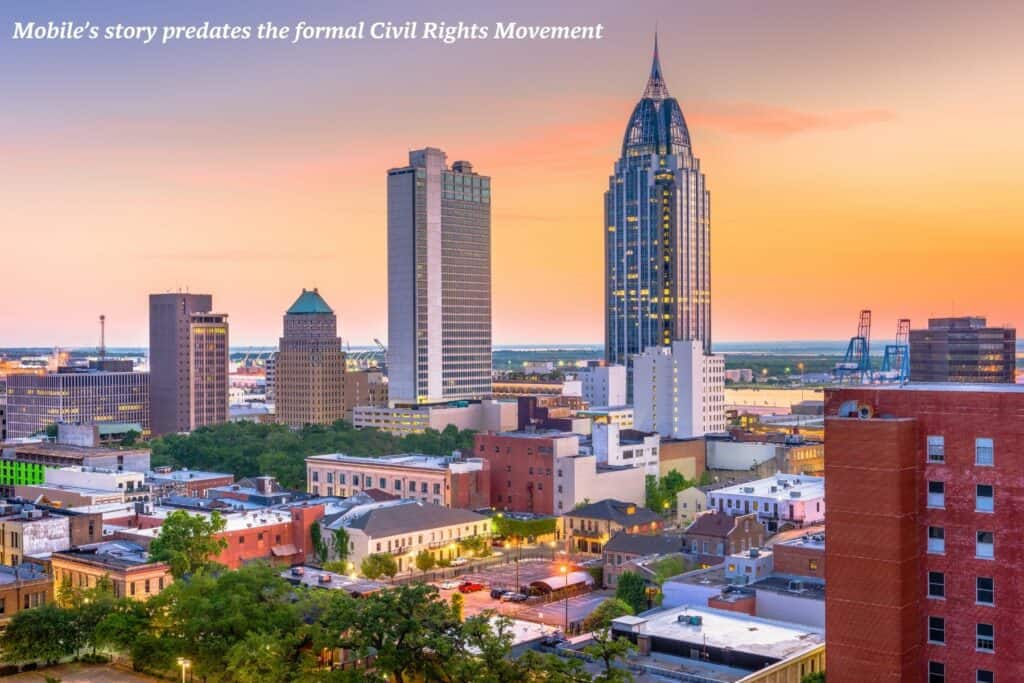
Mobile
An active port city with a unique blend of French, Spanish, and African influences, Mobile’s story predates the formal Civil Rights Movement.
Its waterfront location made it a significant entry point for enslaved Africans, linking the city’s past to many of the injustices that later spurred nationwide protests.
Africatown Heritage House & Clotilda: The Exhibit
In recent years, the discovery of the Clotilda – the last known slave ship to arrive on American shores – brought renewed interest to Mobile’s Africatown.
The Africatown Heritage House now hosts Clotilda: The Exhibit, featuring artefacts, diaries, and first-hand accounts from descendants of those who arrived on the vessel.
Tip: If you want to delve further, guided tours can take you to the site where remnants of the Clotilda were found.
African American Heritage Trail
A possible last landmark on your Civil Rights historic sites itinerary in Alabama, Mobile’s African American Heritage Trail weaves through the downtown area, linking former slave markets, churches, and homes that sheltered Civil Rights activist gatherings.
Some tours stop at cemeteries as well, offering insights into the genealogical records of families who have lived in Mobile for generations.
Even if you have explored other Alabama African American Civil Rights heritage sites, this self-guided trail will reveal fresh facets of the Black community’s struggles and triumphs.
To discover another side of the state, don’t miss our guide to Alabama’s best natural wonders.
More information
To find out more about Alabama, head to the Alabama Travel website.
